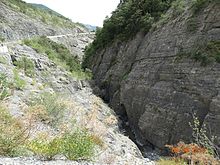Route Napoléon
As Napoleon road the road is France called following the roadmap that Napoleon I (1769-1821) of Golfe-Juan (in Antibes ) via Grasse , Digne , Sisteron and Gap as far as Grenoble lay back after it to the To regain power, having landed in southern France from Elba . This French national road Route nationale 85 , also RN 85 , was created in 1927 and received its name in 1932 . The route with a total length of 335 km was covered by Napoléon's troops in a seven-day forced march between March 1, 1815 and March 7, 1815. The road is marked by signs with imperial eagles , as the march is also known as the "Eagle Flight" ( Vol d 'Aigle ), referring to Napoleon's saying: "The national eagle will fly from church tower to church tower to the towers of Notre-Dame."
history
Napoléon left his place of exile , the Mediterranean island of Elba, on the night of February 26th to 27th, 1815 with the 800 (according to other sources 1,200) loyal followers who had followed him into exile. He sailed north on the Mediterranean for three days on the sailing ship L'Inconstant and landed in Golfe-Juan (near Antibes) on the afternoon of March 1st. Because of the numerous royalists in the Rhone Valley , he had decided to advance across the Alps to Lyon and Paris . The first difficulties arose on March 1st in Antibes. A captain and 20 grenadiers who had broken into the citadel in order to stir up the garrison were arrested there . Napoleon decided to march on immediately to avoid a possible meeting with Massena , the commander of Marseilles .
The night from March 1st to March 2nd the troops bivouacked outside Cannes. On March 2nd the actual march into the mountains began, the train covered 64 km to Seranon. March 3rd led via Castellane to Barrême. The stage of March 4th went via Digne to Malijai. On March 5, Sisteron was reached, the first major royalist town on the way. Although, since the commander there was a supporter of the deposed emperor, it could have turned out to be a good resting place, Napoléon immediately moved on to Gap . On March 6th the route continued to Corps.
On March 7, shortly before Grenoble, the village of Laffrey came into view. Meanwhile General Marchand, in command of Grenoble and unwilling to allow Napoleon free passage, had sent a regiment led by Delessart to blow up the Ponthaut bridge . Since Napoléon, who was advancing very quickly, had preceded him, Delessart had posted his men in a bottleneck in front of Laffrey and blocked the way. On the Prairie de la Rencontre , the "field of encounter", Napoléon met the opposing troops. He ordered his soldiers to take the rifle under his left arm and faced Delessart's regiment alone, which he won with a short speech. On the same day, the unit commanded by La Bédoyère also defected to him. In the evening he moved into Grenoble, the city gates of which had been smashed by the wheelwright from the suburb of Faubourg Saint-Jacques.
From Grenoble, Napoléon could no longer be stopped and marched on to Paris to the triumph of the people, for whom he was already considered emperor again. As predicted, on March 20, 1815, he moved into the Tuileries Palace . This began the so-called Rule of the Hundred Days , which ended after the Battle of Waterloo on June 22, 1815 with the abdication of the emperor. Then Napoléon was exiled to the island of St. Helena , where he died on May 5, 1821.
Marching route
From Grasse to Gap: Grasse, Saint-Vallier-de-Thiery , Castellane , Barrême . From Gap to Grenoble: Gap , Saint-Bonnet-en-Champsaur , Saint-Firmin , Corps , La Mure , Laffrey , Vizille , Grenoble
literature
- Johannes Willms : Napoleon. A biography (Beck's historical library). Beck, Munich 2009, ISBN 978-3-406-58586-9 (EA Munich 2005).
Individual evidence
- ↑ "l'aigle nationale vola de clocher en clocher jusqu'aux tours de Notre-Dame", quoted from Willms: Napoleon , p. 820, note 69.
Web links
- The Route Napoléon (German)
- La Route Napoléon side of the tourist route with map (multilingual)
- Route Napoléon by motorcycle or car (information, map and exact route for GPS)


